Themed collection Emerging Organic Electronics

Emerging organic electronics
Zuo-Quan Jiang, Cyril Poriel and Nicolas Leclerc introduce the Materials Chemistry Frontiers themed collection on emerging organic electronics.

Mater. Chem. Front., 2020,4, 2497-2498
https://doi.org/10.1039/D0QM90038A
Recent advances in the green processing of organic photovoltaic devices from nanoparticle dispersions
Recent advances and perspectives in all aspects of the elaboration of OPV devices from nanoparticle dispersions are reviewed.
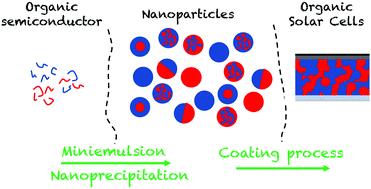
Mater. Chem. Front., 2020,4, 2904-2931
https://doi.org/10.1039/D0QM00361A
Insights into the structural complexity of semi-crystalline polymer semiconductors: electron diffraction contributions
The structural complexity of polymer semiconductors can be revealed by electron diffraction in a TEM on highly oriented and crystalline thin films.

Mater. Chem. Front., 2020,4, 1916-1929
https://doi.org/10.1039/D0QM00230E
Conjugated molecules for colourimetric and fluorimetric sensing of sodium and potassium
New alkali metal ion sensors showing ratiometric colourimetric and fluorimetric responses with high selectivity and low limits of detection.

Mater. Chem. Front., 2020,4, 2370-2377
https://doi.org/10.1039/D0QM00157K
New conjugated polymer nanoparticles with high photoluminescence quantum yields for far-red and near infrared fluorescence bioimaging
The development of new aqueous conjugated polymer nanoparticles with high photoluminescence quantum yields (PLQYs) at the far red and near infrared (NIR) spectral regions (>650 nm) as alternative polymer probes for fluorescence imaging is reported.
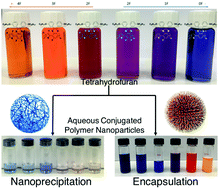
Mater. Chem. Front., 2020,4, 2357-2369
https://doi.org/10.1039/D0QM00195C
Spray-coated PEDOT:OTf films: thermoelectric properties and integration into a printed thermoelectric generator
Spray-coated highly conductive PEDOT material proves efficient for the fabrication of printed thermoelectric generators.
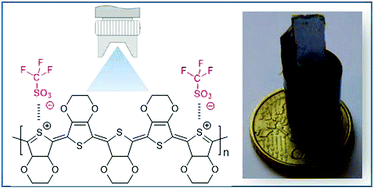
Mater. Chem. Front., 2020,4, 2054-2063
https://doi.org/10.1039/D0QM00265H
Exciton-band tuning induced by the width of the cation in 2D lead iodide perovskite hybrids
The Pb–I–Pb bond angle in 2D A2PbI4 perovskites, previously shown to be correlated to the exciton energy, can be tuned by changing the width of the organic A cation, at least within a limited series of compounds.

Mater. Chem. Front., 2020,4, 2023-2028
https://doi.org/10.1039/D0QM00118J
AIE-active multicolor tunable luminogens: simultaneous mechanochromism and acidochromism with high contrast beyond 100 nm
AIE-active organic intelligent luminescent materials exhibit both multicolor tunable and high-contrast beyond 100 nm mechanochromism and acidochromism.

Mater. Chem. Front., 2020,4, 2047-2053
https://doi.org/10.1039/D0QM00247J
Optimized synthesis of fluorinated dithienyl-diketopyrrolopyrroles and new copolymers obtained via direct heteroarylation polymerization
Optimized synthesis of fDT-DPP and related 3-fluorothiophene comonomers and application in highly fluorinated polymers obtained via direct heteroarylation polymerization.

Mater. Chem. Front., 2020,4, 2040-2046
https://doi.org/10.1039/D0QM00218F
New exciplex systems composed of triazatruxene donors and N-heteroarene-cored acceptors
Three triazatruxene-based donors Tr-Me, Tr-Ph, and Tr-Tol were intermixed with three acceptors 3P-T2T, 3P-T2P, and 3P-Pyr equipping with different heteroarene cores to generate an array of nine blends to probe the feasibility of exciplex formation.
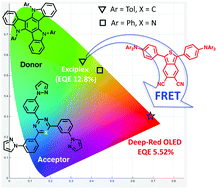
Mater. Chem. Front., 2020,4, 2029-2039
https://doi.org/10.1039/D0QM00188K
The design of an extended multiple resonance TADF emitter based on a polycyclic amine/carbonyl system
A green multiple resonance thermally activated delayed fluorescence (MR-TADF) emitter, DDiKTa, is developed by a simple dimerization strategy of the known MR-TADF emitter DiKTa.
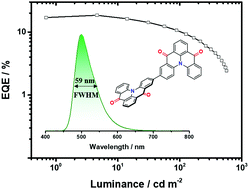
Mater. Chem. Front., 2020,4, 2018-2022
https://doi.org/10.1039/D0QM00190B
Linking triptycene to silole: a fruitful association
We report a remarkable reversible mechanofluorochromism due to the stimulated swinging of a silole core between its triptycene side-groups.
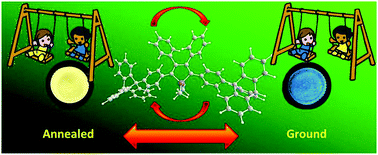
Mater. Chem. Front., 2020,4, 2006-2017
https://doi.org/10.1039/D0QM00087F
Highly efficient exciplex-based OLEDs incorporating a novel electron donor
A high performance green exciplex OLED comprising a novel electron donor DEX with an acceptor PO-T2T can reach an EQEmax of 11.2%, and a red phosphorescent OLED incorporating the green exciplex forming co-host achieves an EQEmax of 24.5%.
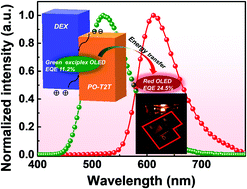
Mater. Chem. Front., 2020,4, 1648-1655
https://doi.org/10.1039/D0QM00116C
Near-IR absorption and photocurrent generation using a first-of-its-kind boron difluoride formazanate non-fullerene acceptor
We report the synthesis and characterization of the first non-fullerene acceptor containing a boron difluoride formazanate core end-capped with N-annulated perylene diimides.
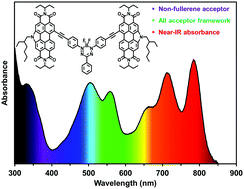
Mater. Chem. Front., 2020,4, 1643-1647
https://doi.org/10.1039/D0QM00109K
The role of dipole moment in two fused-ring electron acceptor and one polymer donor based ternary organic solar cells
The dipole moment of FREAs’ terminals has been unveiled as an important factor and its working mechanism has been thoroughly investigated. Our results demonstrate that the dipole moment should also be taken into account in designing ternary OSCs.

Mater. Chem. Front., 2020,4, 1507-1518
https://doi.org/10.1039/D0QM00016G
A poly(urethane)-encapsulated benzo[2,3-d:6,7-d′]diimidazole organic down-converter for green hybrid LEDs
A novel green emissive material embedded in a resin provides efficient down-conversion in a hybrid LED.
![Graphical abstract: A poly(urethane)-encapsulated benzo[2,3-d:6,7-d′]diimidazole organic down-converter for green hybrid LEDs](/no/Image/Get?imageInfo.ImageType=GA&imageInfo.ImageIdentifier.ManuscriptID=C9QM00771G&imageInfo.ImageIdentifier.Year=2020)
Mater. Chem. Front., 2020,4, 1006-1012
https://doi.org/10.1039/C9QM00771G
Efficient as-cast thick film small-molecule organic solar cell with less fluorination on the donor
Less fluorination, better performance! Devices based on DI3T-1F:PC71BM and DI3T-2F:PC71BM are fabricated for thick-film small molecule-solar cells (SMSCs). Indeed, the devices based on DI3T-1F the devices based on DI3T-1F show a better tolerance to thickness, giving PCE of 8.33% with ∼150 nm, and 5.43% with ∼300 nm, which are 14% and 50% higher than those of DI3T-2F, respectively.

Mater. Chem. Front., 2020,4, 206-212
https://doi.org/10.1039/C9QM00605B
About this collection
Welcome to Materials Chemistry Frontiers themed collection on “organic electronics”.
The impressive development of organic electronics has led to a growing demand of highly efficient organic semiconductors adapted to their use in specific devices including organic light-emitting diodes, organic field-effect transistors, organic photovoltaics and organic biosensors.
The complementarity between chemistry and physics is at the origin of the emergence of organic electronic technologies. Its two pillars, molecular design and devices engineering, have allowed to reach more and more efficient electronic devices over the years. This web theme covers the recent progress on conjugated functional materials for various organic electronic applications and aims to show the importance of complementarity between chemistry and physics.
Guest Editors: Nicolas Leclerc (Université de Strasbourg, CNRS), Zuo-Quan Jiang (Soochow University) and Cyril Poriel (Université de Rennes, CNRS)
More articles will be added as soon as they are published.